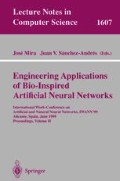Abstract
This paper deals with a top down design methodology of an artificial neural network (ANN) based upon parametric VHDL description of the network. To come off early in the design process a high regular architecture was achieved. Then, the VHDL parametric description of the network was realized. The description has the advantage of being generic, flexible and can be easily changed at the user demand. To validate our approach, an ANN for electrocardiogram (ECG) arrhythmia's classification is passed through a synthesis tool, GALILEO, for FPGA implementation.
Preview
Unable to display preview. Download preview PDF.
References
M. I. Elmasry, «VLSI Artificial Neural Networks Engineering», Kluwer Academic Publshers.
Richard P. Lippmann, «An Introduction to computing with Neural Nets», IEEE ASSP Magazine, pp. 4–22. April 1987.
Philip Trealeven, Macro Pacheco and Marley Vellasco, «VLSI Architectures for Neural Networks», IEEE MICRO, pp. 8–27, December 1989.
Y. Arima, K. Mashiko, K. Okada, «A Self-Learning Neural Network Chip with 125 Neurons and 10K Self-Ornization Synapses», Symposium on VLSI Circuits, pp. 63–64, 1990 IEEE.
H. Ossoing, «Design and FPGA-Implementation of Neural Network», ICSPAT'96, Pp. 939–943.
Charles E. Cox and W. Ekkehard Blanz, «GANGLION—A Fast Field Programmable Gate Array Implementation of a Connectionist Classifier», IEEE JSSC, Vol. 27, No. 3, pp. 288–299, March 1992.
R. Airiau, J. M. Berge, V. Olive, J. Rouillard “VHDL du language a la modelisation”, Presses Polytechniques et Universitaires Romandes et CNEST-ENST.
R. Airiau, J. M. Berge, V. Olive, “Circuit Synthesis with VHDL”, Kluwer Academic Publishers.
Daniel Gajski, Nikil Dutt, Allen Wu, Steve Lin, “High level Synthesis-Introduction to Chip and System Design”, Kluwer Academic Publishers.
XACT user manual.
M. S. Ben Romdhane, V. K. Madissetti and J. W. Hines, “Quick-Turnaround ASIC Design in VHDL Core-Based Behavioral Synthesis”, Kluwer Academic Publishers.
N. Izeboudjen and A. Farah, “A New Neural Network System for arrhythmia's Classification,” NC'98, International ICSC/IFAC Symposium on neural Computation. Vienna, September 23–25, pp. 208–212.
GALILEO HDL Synthesis Manual.
Author information
Authors and Affiliations
Editor information
Rights and permissions
Copyright information
© 1999 Springer-Verlag Berlin Heidelberg
About this paper
Cite this paper
Izeboudjen, N., Farah, A., Titri, S., Boumeridja, H. (1999). Digital implementation of artificial neural networks: From VHDL description to FPGA implementation. In: Mira, J., Sánchez-Andrés, J.V. (eds) Engineering Applications of Bio-Inspired Artificial Neural Networks. IWANN 1999. Lecture Notes in Computer Science, vol 1607. Springer, Berlin, Heidelberg . https://doi.org/10.1007/BFb0100480
Download citation
DOI: https://doi.org/10.1007/BFb0100480
Published:
Publisher Name: Springer, Berlin, Heidelberg
Print ISBN: 978-3-540-66068-2
Online ISBN: 978-3-540-48772-2
eBook Packages: Springer Book Archive

